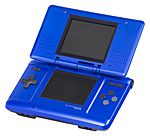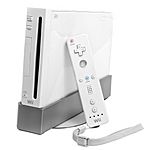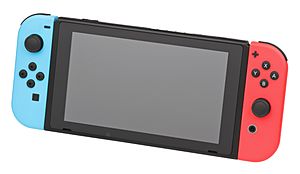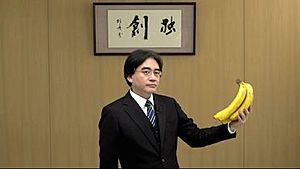Satoru Iwata facts for kids
Quick facts for kids
Satoru Iwata
|
|
|---|---|
|
岩田 聡
|
|
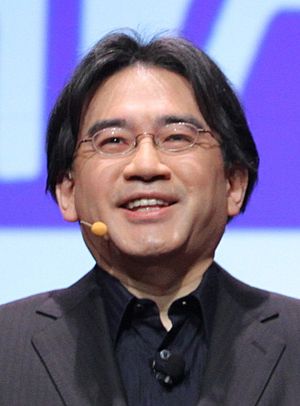
Iwata at Game Developers Conference in 2011
|
|
| 4th President of Nintendo | |
| In office May 24, 2002 – July 11, 2015 |
|
| Preceded by | Hiroshi Yamauchi |
| Succeeded by | Tatsumi Kimishima |
| Personal details | |
| Born | December 6, 1959 Sapporo, Hokkaido, Japan |
| Died | July 11, 2015 (aged 55) Kyoto University Hospital, Kyoto, Japan |
| Cause of death | Complications from bile duct cancer |
| Spouses | Kayoko Iwata (岩田 佳代子, Iwata Kayoko) |
| Alma mater | Tokyo Institute of Technology |
| Employer | HAL Laboratory (1980–2000) Nintendo (2000–2015) |
| Notable works | EarthBound, Balloon Fight, Kirby, Mario, The Legend of Zelda, Metroid, Pokémon, Super Smash Bros. |
| Signature | |
Satoru Iwata (Japanese: 岩田 聡, Hepburn: Iwata Satoru, December 6, 1959 – July 11, 2015) was a Japanese businessman, video game programmer, designer, and producer. He was the fourth president and chief executive officer (CEO) of Nintendo from 2002 until his death in 2015. He helped make video games popular for many different people. He focused on fun and new games, not just powerful game consoles.
Born in Sapporo, Japan, Iwata loved video games from a young age. He even created his first simple game while in high school. He studied computer science at the Tokyo Institute of Technology. In 1980, he joined the game company HAL Laboratory while still in college. At HAL, he worked as a programmer and worked closely with Nintendo. He made his first commercial game in 1983. Games he helped create include EarthBound and many Kirby games.
After HAL Laboratory faced financial trouble, Iwata became its president in 1993. He helped the company become stable again. Later, he worked on the Pokémon and Super Smash Bros. series. Iwata joined Nintendo in 2000 as the head of its planning division.
Nintendo grew a lot under Iwata's leadership. When the previous president, Hiroshi Yamauchi, retired, Iwata became Nintendo's president in May 2002. Under Iwata, Nintendo created the Nintendo DS and Wii game consoles. These consoles helped the company become very successful. Iwata, who called himself a gamer, wanted to make video games fun for everyone. He used a "blue ocean" business idea, which means creating new markets instead of fighting in old ones.
By 2009, Nintendo had record profits. Barron's magazine even named Iwata one of the top 30 CEOs in the world. Later, hardware like the Nintendo 3DS and Wii U did not sell as well as the Wii. Nintendo's sales dropped, and the company had financial losses. Iwata chose to cut his own salary in 2011 and 2014 to help the company. In 2015, Nintendo started focusing on the growing mobile game market. They partnered with mobile company DeNA.
Throughout his career, Iwata connected with Nintendo fans. He used social media and appeared regularly in "Iwata Asks" and "Nintendo Direct" videos. He became the friendly public face of the company.
In June 2014, doctors found a tumor in Iwata's bile duct during a check-up. He had surgery to remove it and returned to work in October. The problem came back in 2015, and Iwata passed away on July 11 at age 55. Many people in the gaming world and fans shared their sadness and thanks for his work. Iwata received the Lifetime Achievement Award after his death at the 2015 Golden Joystick Awards and the 2016 D.I.C.E. Awards.
Contents
- Early Life and Computer Fun
- Working at HAL Laboratory
- Leading Nintendo: Early Years (2000–2002)
- Nintendo's Big Comeback (2003–2009)
- Financial Challenges (2010–2014)
- Mobile Games and the Nintendo Switch (2015)
- Connecting with Fans
- Other Projects and Contributions
- Illness and Passing
- Iwata's Impact and Legacy
- See also
Early Life and Computer Fun
Satoru Iwata was born on December 6, 1959, in Sapporo, Japan. His father was a government official. In middle and high school, Iwata showed strong leadership skills. He was often class president or student council president.
His first experience with computers was in middle school. He played a simple number game called Game 31 on a demo computer. In 1974, he bought his first programmable calculator, an HP-65, with money he saved.
After starting Hokkaido Sapporo Minami High School in 1975, he began making his own games. He created simple number games like Volleyball and Missile Attack using an electronic calculator.
In 1978, he got his first computer, a Commodore PET. He took it apart to understand how it worked. This computer had a central processing unit (CPU) similar to the one Nintendo later used for the Nintendo Entertainment System (NES).
Iwata went to the Tokyo Institute of Technology in 1978 to study computer science. His professor, Tomohiko Uematsu, noticed how good Iwata was at programming. He said Iwata could write programs faster and more accurately than other students.
While in school, Iwata worked as an unpaid helper at Commodore Japan. He helped with technical tasks and software development. He wanted to spend more time with computers and learn secrets not available to everyone. Iwata and his friends rented an apartment in Akihabara and formed a club to create games. Classmates called his room "Game Center Iwata." By 1980, employees from a department store invited him to join their company, HAL Laboratory, Inc..
Working at HAL Laboratory
Iwata started working part-time as a programmer for HAL Laboratory in 1980 while still at university. One of their first inventions was a device that let older computers show graphics for video games. With this device, Iwata and HAL created games similar to popular arcade games. HAL was the first company to get a license from Namco to make games.
After graduating in 1982, he joined HAL full-time. He was the fifth employee and the only programmer. Iwata's father was not happy with his career choice and did not speak to him for six months.
In 1983, Iwata became the coordinator of software production. He helped HAL build a relationship with Nintendo to make games for the new Nintendo Entertainment System (NES). He traveled to Kyoto to ask for permission, and Nintendo agreed.
His first game published for sale was Joust for the NES. He also worked on Balloon Fight, NES Open Tournament Golf, EarthBound, and the Kirby games. For Open Tournament Golf, Iwata had to create his own way to compress data. This was needed to fit all 18 golf courses onto an NES game cartridge.
Iwata was very skilled at programming. He often worked on weekends and holidays because he loved what he did. In 1993, HAL Laboratory was close to going bankrupt. Nintendo's president, Hiroshi Yamauchi, insisted that Iwata become the president of HAL. With Nintendo's help, Iwata turned the company around and made it financially stable within six years. He worked hard to learn about management, reading books and asking for advice.
Even though he wasn't at Nintendo yet, Iwata helped develop Pokémon Gold and Silver for the Game Boy Color in 1999. He created tools to compress graphics for the games. He also helped program Pokémon Stadium for the Nintendo 64. He took the battle system code from Pokémon Red and Green and moved it to the new game in just one week.
According to Tsunekazu Ishihara, the president of The Pokémon Company, Iwata was key to bringing Pokémon to other countries. He also helped Masahiro Sakurai develop Super Smash Bros. for the Nintendo 64.
Leading Nintendo: Early Years (2000–2002)
In 2000, Iwata joined Nintendo as the head of its corporate planning division. He also became a member of the board of directors. For the next two years, he worked to lower the cost and time it took to make games, while keeping them high quality. Nintendo's profits increased by 20% and 41% during his first two years.
On May 24, 2002, Yamauchi, who had been president since 1949, retired. Iwata became Nintendo's fourth president with Yamauchi's approval. He was the first Nintendo president not related to the Yamauchi family since the company started in 1889. Yamauchi asked Iwata to create new ideas and hardware that showed those ideas.
When Iwata became president, Nintendo was still making money, but not as much as other console makers. The GameCube was not selling as well as Sony's PlayStation 2 and Microsoft's Xbox. Online gaming was also becoming popular, and Nintendo had not yet entered this market. Iwata was careful, saying, "We're not negative toward the idea of going online. We're just practical."
He also helped Nintendo and Capcom work together, which made the GameCube more appealing. In 2002, Iwata said he felt the gaming industry was becoming too exclusive. He wanted to make hardware and games that everyone would enjoy, not just focus on the best graphics.
One of his first actions as president was to meet directly with many employees. This was very different from Yamauchi, who rarely met with staff. Shigeru Miyamoto said the old atmosphere was "stuffy" and Iwata "improved the ventilation." Iwata wanted to communicate with his employees personally. If they disagreed with him, he would suggest they follow their own ideas. He believed "creators only improve themselves by taking risks."
Iwata also brought more data and science into the company's business decisions. Yamauchi made choices based on his feelings, but Iwata used data to explain his ideas. Iwata also promoted Miyamoto and other key people to important director roles, equal to his own.
Nintendo's Big Comeback (2003–2009)
Iwata spoke at the 2003 Tokyo Game Show, saying there was an urgent problem in the gaming market. He noted that interest in video games was declining. After a year of looking into it, Nintendo decided that pushing powerful hardware was not the best way to promote games. They chose to focus on creating fun software instead.
In 2004, Nintendo changed its internal structure. Iwata brought different departments together to encourage teamwork. In 2005, he started a "User Expansion Project." This allowed employees who usually didn't work on games to suggest new game ideas.
In a March 2004 interview, Iwata said, "Games have come to a dead end." He felt that game makers spent too much time on "hardcore" gamers. He wanted to prove that Nintendo, seen as a "conservative" company, could be a leader in entertainment. Iwata used a "blue ocean" idea to help Nintendo compete. Instead of focusing on technical power, he used his game development experience to create new and fun hardware and games.
Nintendo DS: A New Way to Play
Iwata helped bring Nintendo's handheld business back to life. They moved from the Game Boy Advance to the Nintendo DS. The DS had a unique design with two screens and a touchscreen, which allowed for new kinds of games. The idea for two screens came from Yamauchi before he retired. Miyamoto suggested the touchscreen.
The Nintendo DS was very profitable. It became the second-best selling video game console of all time, selling over 154 million units. In June 2004, Iwata met with Dr. Ryuta Kawashima to discuss a game for non-gamers. This project became Brain Age: Train Your Brain in Minutes a Day!, released in 2005. Iwata personally watched over the development of the Brain Age series. The Brain Age series helped make the Nintendo DS popular and sold over 30 million copies.
Later versions of the Nintendo DS, like the DS Lite and DSi, also sold well. The DS Lite had brighter screens and a thinner design. It sold nearly 94 million units. Iwata wanted to expand from one DS per household to one per person. The DSi, the third version, aimed for this idea, with the "i" meaning a single person. The DSi was even thinner and had two cameras, SD card support, and the "Nintendo DSi Shop." These quick releases were different from the usual five-year cycle for game systems. Iwata wanted to avoid telling customers to wait for a price drop.
Wii: Fun for Everyone
Discussions about a new home console began in 2003 between Iwata, Miyamoto, and Genyo Takeda. Iwata pushed for a revolutionary product that became the Wii. He told Takeda to think outside the box. The main idea was that "a Mom has to like it." Iwata challenged engineers to make the Wii as thin as three DVD cases stacked together, which they did.
Takeda's team focused on using less power while keeping or improving performance. Iwata suggested that the console should not use a typical controller. This would make gaming easier for everyone. Miyamoto led the development of the new controller. After many tries, Takeda found a CMOS sensor that became key to the remote. With accelerometers, they created motion controls.
The console was first called "Revolution." Iwata revealed the Wii at E3 2005, holding it above his head to show how small and light it was. The Wii Remote was shown later in September 2005. Iwata repeated his goal of growing the gaming market. He stressed the need to make controls simpler. He insisted the Wii Remote be called a "remote" to show it was easy for anyone to use.
The Wii made motion control games popular and was very successful for Nintendo. It nearly doubled the company's stock price. The Wii created a new type of gaming for families. By 2009, Nintendo had record sales and profits. Barron's included Iwata on their list of top 30 CEOs from 2007 to 2009.
Quality-of-Life Products

Starting with the Wii in 2006, Iwata focused on products that improved quality of life. The Wii Fit series, thought up by Miyamoto, was a great example of this. At E3 2009, Iwata showed a new product for the Wii: the Wii Vitality Sensor. This device measured things like pulse and would be used in relaxation products.
Iwata saw this device as a way to continue his "blue ocean" strategy. He felt that motion controls were becoming a "red ocean," meaning too many companies were making similar products. The Vitality Sensor aimed to offer a new way to play games and keep Nintendo innovating. However, testing showed it didn't work as well as hoped, and Nintendo put its release on hold.
In January 2014, Iwata announced a ten-year plan for the company. It was based on quality-of-life products, targeting a new market outside video games. The first device in this plan was a fatigue and sleep sensor, announced in October 2014. Unlike the Vitality Sensor, this sleep sensor was a stand-alone product that you wouldn't need to wear.
After Iwata's death in 2015, people wondered if Nintendo would continue this plan. The sleep sensor was stopped by February 2016. However, Tatsumi Kimishima, the next president, said that research into quality-of-life products would continue. Nintendo products like the Nintendo Switch, Pokémon Go (which makes you travel outside), and Pokémon Sleep (based on sleep patterns) all continue Iwata's idea. The Switch game Ring Fit Adventure is also seen as a successor to Wii Fit.
Financial Challenges (2010–2014)
| Nintendo Net Sales by Fiscal Year (2006–2015) | ||||
|---|---|---|---|---|
| Fiscal year | Sales (mil ¥) | |||
| 2006 | 508,827 | |||
| 2007 | 966,534 | |||
| 2008 | 1,672,423 | |||
| 2009 | 1,838,622 | |||
| 2010 | 1,182,177 | |||
| 2011 | 1,014,345 | |||
| 2012 | 647,652 | |||
| 2013 | 635,422 | |||
| 2014 | 571,726 | |||
| 2015 | 549,780 | |||
| Nintendo's yearly net sales in millions of yen Note: Green means the company made money, black means it lost money. |
||||
New hardware under Iwata, like the Nintendo 3DS and Wii U, were not as successful as the DS and Wii. Nintendo's finances started to decline in 2010. The Nintendo 3DS, a handheld with 3D effects without special glasses, was hoped to boost the company. However, low sales when it launched in 2011 caused Nintendo's stock to drop. The price of the 3DS was cut from US$250 to US$170. Sales continued to be lower than expected.
Iwata later admitted in 2014 that he had misjudged the market. He had not fully understood how people's lifestyles had changed since the Wii came out. He kept focusing on family-friendly games, even though their popularity was decreasing.
The Wii U, released in 2012, was sold for less than it cost to make. Nintendo hoped to make up the money with strong game sales. Adding HD graphics, which the original Wii didn't have, put pressure on game development teams. This led to delays in games. The console did not sell as well as expected. It became Nintendo's slowest-selling platform, with 9.5 million units sold by June 2015. Miyamoto said that people misunderstood the console's idea. Iwata later admitted the Wii U was a failure as a follow-up to the Wii.
The poor sales of both the 3DS and Wii U led some to suggest that Iwata should resign. Nintendo's total sales dropped from its highest point in 2009 to much lower in 2015. The company lost money in 2012 and 2014. In 2010, Iwata earned a modest salary. He voluntarily cut his salary in half in 2011 and 2014 to apologize for the poor sales. Other Nintendo directors also had their pay cut. This helped ensure that Nintendo employees kept their jobs. The company finally returned to making a profit at the end of the 2015 fiscal year. This was thanks to popular games like Pokémon Omega Ruby and Alpha Sapphire, and Super Smash Bros. for Nintendo 3DS and Wii U.
In June 2013, Iwata also became the CEO of Nintendo of America. One of his first changes was to stop holding large press conferences at E3. Instead, he chose to have several smaller events, each for a specific group of people. In late 2013, Iwata thought of an idea for physical toys that could connect with Nintendo's games. This idea became the Amiibo figures, which launched less than a year later. Amiibo were a huge success, selling over 6 million figures by the end of 2014. By March 2016, sales of figures and cards reached over 64 million units.
Mobile Games and the Nintendo Switch (2015)
In the early 2010s, the success of Apple Inc.'s mobile App Store worried game developers. They thought gaming might move to smart devices. In 2010, Iwata called Apple the "enemy of the future." However, in 2011, he seemed completely against Nintendo moving into the mobile market. He said the company would "cease to be Nintendo" if they did. He believed mobile gaming might care more about making money than game quality.
Over the next few years, his view slowly changed as mobile gaming grew. In 2012, he admitted that mobile devices were strong competitors. But he still believed in Nintendo's abilities. In March 2014, Iwata told shareholders, "… I believe that the era has ended when people play all kinds of games only on dedicated gaming systems." He noted how convenient mobile devices were for quick entertainment. People criticized his stubbornness about moving to mobile. This negatively affected Nintendo's finances and popularity.
In March 2015, Iwata decided to focus some of Nintendo's efforts on the growing mobile game market. They made a big partnership with mobile company DeNA to publish games. This was a change from Nintendo's old business model, which focused on console-exclusive games to make people buy their systems. Iwata stressed that Nintendo's IPs (like Mario and Pokémon) would be used in mobile games, but their quality would not be lowered. He also said the main goal was to reach as many people as possible, not just to make the most money. He believed that common "free-to-play" mobile games, which he called "free-to-start," could harm the future quality of games. He felt their business model didn't fit Nintendo's core values.
Iwata oversaw the development of the Nintendo Switch during his final months. He was the console's head developer. In a 2017 interview, Miyamoto said Iwata's goal for the Switch was to make it portable and allow people to connect with each other. Iwata focused on the technical parts of the device at this stage.
Connecting with Fans
In his early years as Nintendo's president, Iwata often avoided public appearances. He preferred to spend more time programming. However, his attitude changed, and he became a big part of Nintendo's public relations. Iwata helped Nintendo connect better with its fans. He often replied to them on social media. He also shared insights about Nintendo's employees, games, and hardware through his interview series "Iwata Asks." This series started in 2006. It showed the friendly relationships between Iwata and other Nintendo developers. It also revealed more about Nintendo's inner workings, which was usually kept secret.
In 2011, Iwata helped start Nintendo Direct. These were online press conferences open to everyone. They revealed upcoming Nintendo games and products outside of typical industry events. These videos were often funny and quirky, showing Iwata's own personality. This was very different from the serious tones of Sony and Microsoft. One video showed a fake battle between him and Nintendo of America President Reggie Fils-Aimé. This was to show Mii characters in Super Smash Bros. for Nintendo 3DS and Wii U.
These videos often led to Internet memes. For example, the phrase "please understand" was often used by Iwata for delays or bad news. People also added "[Iwata laughs]" to online posts, referring to his frequent laughter in "Iwata Asks" segments. Images of Iwata silently staring at bananas in an E3 2012 video also became popular.
Because of his presence in "Iwata Asks" and Nintendo Direct, Iwata became the public face of Nintendo. He enjoyed talking with reporters and would prepare stories to entertain them. Even when he was busy, he would chat casually with interviewers.
Other Projects and Contributions
Iwata helped start Creatures Inc. and The Pokémon Company. He later helped with licensing changes for The Pokémon Company. In 1998, Iwata helped his friend Shigesato Itoi create Hobonichi. Iwata worked as the company's IT Manager. He enjoyed this role and still held it in 2007, even while running Nintendo full-time.
Soon after becoming Nintendo's president, Iwata joined a development team at HAL Laboratory. He worked on Super Smash Bros. Melee for the GameCube. This allowed him to continue his passion for programming.
From his work with the Brain Age series, Iwata helped make educational games. These included Kanji Sonomama Rakubiki Jiten DS and English Training: Have Fun Improving Your Skills!. He also worked on Animal Crossing, Mario, Metroid Prime, and The Legend of Zelda game series. He even had a small appearance in WarioWare: Smooth Moves. Iwata also helped develop Pokémon Go, an augmented reality mobile game, starting in 2013. The game was shown to the public in September 2015, two months after he passed away.
Illness and Passing
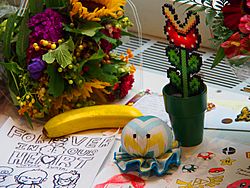
On June 5, 2014, Nintendo announced that Iwata would not attend E3 2014 due to health issues. On June 24, Iwata told shareholders that he had surgery the week before. Doctors found a tumor in his bile duct during a regular check-up. After about four months of recovery from a successful surgery, he returned to work in October. He lost a lot of weight but said he felt healthier. Iwata made his first public appearance on a Nintendo Direct on November 5. He looked "thin and pale." He updated his Mii, a digital avatar, in June 2015 to show his slimmer self.
On January 28, 2015, Iwata got a high fever and was thought to have the flu. A meeting with shareholders was postponed. After attending another shareholder meeting on June 26, Iwata became ill again and was hospitalized. Even in the hospital, Iwata continued to work on his laptop. He gave feedback on Pokémon Go to Tsunekazu Ishihara. He passed away on July 11 at age 55 due to complications from the tumor. He was survived by his wife, Kayoko. Nintendo announced his death the next day.
Flags at Nintendo's headquarters were lowered to half-staff on July 13. Nintendo's offices worldwide had a day of silence on social media to remember Iwata. Many people in the gaming industry and fans shared their sadness and thanks for his achievements. Fans created memorials around the world, including at the Japanese Embassy in Moscow and the Nintendo World Store in Manhattan. Shuhei Yoshida, president of SCE Worldwide Studios, said, "I pray that Mr. Iwata, who contributed so much to the development of the gaming industry, rests in peace." Composer and director Junichi Masuda, known for Pokémon games, tweeted, "He was a man who understood Pokémon, and a great leader."
The Tokyo Institute of Technology released a memorial statement on August 4. Iwata's former classmates and professors shared their memories. At The Game Awards 2015, Reggie Fils-Aimé gave a tribute to Iwata. He described him as "fearless" and "unique."
Hours after Iwata's death was announced, a photo of a rainbow over Nintendo's headquarters in Kyoto was shared widely on Twitter. It was called "the Rainbow Road to heaven," referring to a stage in the Mario Kart series. Buddhist funeral services for Iwata were held in Kyoto on July 16 and 17. About 4,100 people attended, despite a typhoon. Among those who came were Reggie Fils-Aime, Shigeru Miyamoto, Genyo Takeda, and Iwata's close friend Masahiro Sakurai. After the service, Iwata's remains were cremated.
After Iwata's death, Shigeru Miyamoto and Genyo Takeda temporarily managed the company together. On September 14, Nintendo announced that Tatsumi Kimishima would become the fifth president of Nintendo.
Iwata's Impact and Legacy
On my business card, I am a corporate president. In my mind, I am a game developer. But in my heart, I am a gamer.
Throughout his life, Iwata was known for his new ideas and for changing the world of gaming. He was seen as the spirit of Nintendo: playful, quirky, and fun. Many called him a "genius" in programming. His hands-on way of leading earned him respect from both developers and gamers. The start of Iwata's "Heart of a Gamer" speech at GDC 2005 shows who he was: a humble businessman who loved video games.
He and others at Nintendo, like Miyamoto, are credited with greatly expanding the gaming market. They created a new type of gamer. By focusing on new audiences instead of competing directly with Microsoft and Sony, Iwata successfully reached his goals. He was called a "gentle revolutionary." The simple appeal of the Nintendo DS and Wii helped grow the market. Chris Kohler of Wired magazine said, "thanks to Nintendo's Satoru Iwata, we're all gamers now." This referred to the big increase in video game popularity after the DS and Wii came out. Although respected, he was criticized for being stubborn about moving Nintendo into the mobile market. After Iwata's death, Reggie Fils-Aimé said, "... it will be years before his impact on both Nintendo and the full video game industry will be fully appreciated."
In October 2015, a fan-made Amiibo figure of Iwata's Mii avatar was sold for US$1,900 on eBay. All the money went to the Child's Play charity in his memory. Iwata was given the Lifetime Achievement Award at the 2015 Golden Joystick Awards and the 2016 DICE Awards after his death. At the 2016 Game Developers Choice Awards, a short animated film by David Hellman honored Iwata. In July 2019, Hobonichi published a book in Japan called Iwata-san. It includes parts from "Iwata Asks" interviews and talks with his close friends, like Shigeru Miyamoto. The book is being translated into other languages. Viz Media published it in North America as Ask Iwata in April 2021.
Video Game Tributes
A message honoring Iwata was placed at the end of the credits for Star Fox Zero. It read, "This game is dedicated to our wingman who fell in battle." Another possible tribute is in the Nintendo Switch game The Legend of Zelda: Breath of the Wild, which was being made when he died. A character who looks like Satoru Iwata asks the player to go to Satori Mountain to find the mystical Lord of the Mountain. "Satori" sounds like "Satoru," and the Lord of the Mountain is a guiding spirit. This makes many think it's a tribute to Iwata.
In September 2017, people found that an old NES game called Golf, which Iwata programmed, was hidden in the Nintendo Switch system. You could play it by moving the Joy-Con controllers like Iwata moved his hands in Nintendo Direct videos, but only when the system clock was set to July 11 (the day he died). Nintendo later removed this with a system update.
In Pokémon Ultra Sun and Ultra Moon, if you visit the Game Freak building with Pokémon from Pokémon Gold and Silver, a character talks about how they had trouble getting data onto the Game Boy Color game cards. They say an "amazing guy" helped them. This is a nod to Iwata's help with Gold and Silver.
See also
 In Spanish: Satoru Iwata para niños
In Spanish: Satoru Iwata para niños
- History of Nintendo



